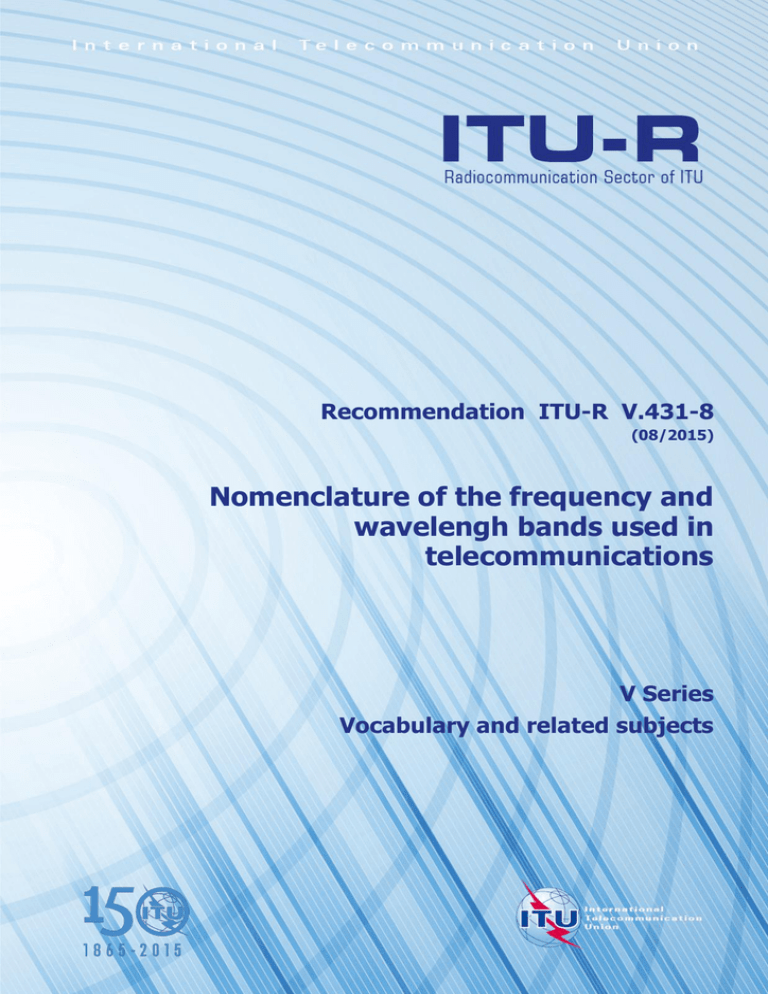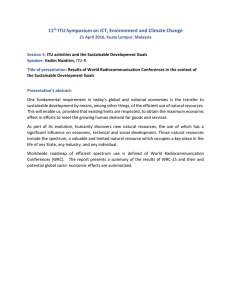
Recommendation ITU-R V.431-8
(08/2015)
Nomenclature of the frequency and
wavelengh bands used in
telecommunications
V Series
Vocabulary and related subjects
ii
Rec. ITU-R V.431-8
Foreword
The role of the Radiocommunication Sector is to ensure the rational, equitable, efficient and economical use of the radiofrequency spectrum by all radiocommunication services, including satellite services, and carry out studies without limit
of frequency range on the basis of which Recommendations are adopted.
The regulatory and policy functions of the Radiocommunication Sector are performed by World and Regional
Radiocommunication Conferences and Radiocommunication Assemblies supported by Study Groups.
Policy on Intellectual Property Right (IPR)
ITU-R policy on IPR is described in the Common Patent Policy for ITU-T/ITU-R/ISO/IEC referenced in Annex 1 of
Resolution ITU-R 1. Forms to be used for the submission of patent statements and licensing declarations by patent holders
are available from http://www.itu.int/ITU-R/go/patents/en where the Guidelines for Implementation of the Common
Patent Policy for ITU-T/ITU-R/ISO/IEC and the ITU-R patent information database can also be found.
Series of ITU-R Recommendations
(Also available online at http://www.itu.int/publ/R-REC/en)
Title
Series
BO
BR
BS
BT
F
M
P
RA
RS
S
SA
SF
SM
SNG
TF
V
Satellite delivery
Recording for production, archival and play-out; film for television
Broadcasting service (sound)
Broadcasting service (television)
Fixed service
Mobile, radiodetermination, amateur and related satellite services
Radiowave propagation
Radio astronomy
Remote sensing systems
Fixed-satellite service
Space applications and meteorology
Frequency sharing and coordination between fixed-satellite and fixed service systems
Spectrum management
Satellite news gathering
Time signals and frequency standards emissions
Vocabulary and related subjects
Note: This ITU-R Recommendation was approved in English under the procedure detailed in Resolution ITU-R 1.
Electronic Publication
Geneva, 2015
ITU 2015
All rights reserved. No part of this publication may be reproduced, by any means whatsoever, without written permission of ITU.
Rec. ITU-R V.431-8
1
RECOMMENDATION ITU-R V.431-8
Nomenclature of the frequency and wavelength bands
used in telecommunications
(1953-1956-1959-1963-1966-1974-1978-1982-1986-1993-2000-2015)
Scope
This text recommends the use of the hertz (Hz) as the unit of frequency, and the nomenclature to be used for
the description of frequency and wavelength bands. It also provides extended information on nomenclature
used in some applications.
Keywords
Hertz, frequency bands, wavelength bands
Related ITU Recommendations
Recommendation ITU-R V.430-4
Use of the international system of units (SI)
Recommendation ITU-R V.573-6
Radiocommunication vocabulary
Recommendation ITU-R V.574-5
Use of the decibel and the neper in telecommunications
Recommendation ITU-R V.665-3
Traffic intensity unit
The ITU Radiocommunication Assembly,
considering
a)
that the merits of Heinrich Hertz (1857-1897) as a research worker on the basic phenomena
of radio waves, are universally recognized, as was confirmed at the centenary of his birth; and that as
early as 1937 the International Electrotechnical Commission (IEC) adopted the hertz (symbol: Hz) as
a name for the unit of frequency (see inter alia, International Standard IEC 60027);
b)
that the nomenclature in this Recommendation should be as synoptic as possible and that the
designation of frequency bands should be as concise as possible,
recommends
1
that the hertz (Hz) be accepted for use in publications of the ITU, as the name for the unit of
frequency in accordance with Recommendation ITU-R V.430 on the use of the international system
of units (SI);
2
that administrations should always use the nomenclature of the frequency and wavelength
bands given in Table 1 and Notes 1 and 2, which take account of No. 2.1 of the Radio Regulations
(RR).
2
Rec. ITU-R V.431-8
TABLE 1
Band
number
Symbols
Frequency range
(lower limit exclusive,
upper limit inclusive)
3
ULF
300-3 000 Hz
4
VLF
3-30 kHz
5
LF
30-300 kHz
6
MF
7
Corresponding metric
subdivision
Metric
abbreviations
for the bands
Hectokilometric waves
B.hkm
Myriametric waves
B.Mam
Kilometric waves
B.km
300-3 000 kHz
Hectometric waves
B.hm
HF
3-30 MHz
Decametric waves
B.dam
8
VHF
30-300 MHz
9
UHF
10
11
Metric waves
B.m
300-3 000 MHz
Decimetric waves
B.dm
SHF
3-30 GHz
Centimetric waves
B.cm
EHF
30-300 GHz
Millimetric waves
B.mm
12
300-3 000 GHz
Decimillimetric waves
B.dmm
13
3-30 THz
Centimillimetric waves
B.cmm
14
30-300 THz
15
300-3 000 THz
Micrometic waves
B.m
Decimicrometric waves
B.dm
NOTE 1 – “Band number N” extends from 0.3 10N to 3 10N Hz.
NOTE 2 – Symbols: Hz: hertz
k: kilo (103), M: mega (106), G: giga (109), T: tera (1012)
: micro (10–6), m: milli (10–3), c: centi (10–2), d: deci (10–1)
da: deca (10), h: hecto (102), Ma: myria (104).
NOTE 3 – This nomenclature, used for designating frequencies in the field of telecommunications, may be
extended to cover the ranges shown below, as is proposed by the International Union of Radio Science (URSI)
(see Table 2).
TABLE 2
Band
number
Symbols
–1
0
Frequency range
(lower limit exclusive,
upper limit inclusive)
0.03-0.3 Hz
ELF
Corresponding metric
subdivision
Gigametric waves
Metric
abbreviations
for the bands
B.Gm
0.3-3 Hz
Hectomegametric waves
B.hMm
1
3-30 Hz
Decamegametric
B.daMm
2
30-300 Hz
Megametric
B.Mm
NOTE 4 – In most countries the frequency ranges used for FM sound broadcasting and television are
designated by the Roman numerals I to V. The frequency ranges are indicated in Table 3. It should be noted
that these ranges are, in some cases, not exclusive to the broadcasting services.
Rec. ITU-R V.431-8
3
TABLE 3
Frequency range
(MHz)
Designation
Region 1
Region 2
Region 3
I
47-68
54-68
47-68
II
87.5-108
88-108
87-108
III
174-230
174-216
174-230
IV
470-582
470-582
470-582
V
582-960
582-890
582-960
NOTE 5 – Certain frequency bands are sometimes designated by letter other than the symbols and
abbreviations recommended in Tables 1 and 2. The symbols in question consist of capital letters which may
be accompanied by an index (usually a small letter). There is at present no standard correspondence between
the letters and the frequency bands concerned, and the same letter may be used to designate a number of
different bands. It is not advisable to use these symbols in ITU publications. If, however, a letter symbol is
used, reference should be made to the corresponding frequency band limits or at least to a frequency in the
band, if that information is sufficient in itself, the first time the symbol appears in the text. For information,
letter designations used by some authors, mainly in the field of radar and space communications, are indicated
in Table 4.
TABLE 4
Radar (GHz)
Letter
symbols
(1)
Space radiocommunications
Spectrum
regions
Examples
Nominal designations
Examples
(GHz)
L
1-2
1.215-1.4
1.5 GHz band
1.525-1.710
S
2-4
2.3-2.5
2.7-3.4
2.5 GHz band
2.5-2.690
C
4-8
5.25-5.85
4/6 GHz band
3.4-4.2
4.5-4.8
5.85-7.075
X
8-12
8.5-10.5
–
–
Ku
12-18
13.4-14.0
15.3-17.3
11/14 GHz band
12/14 GHz band
10.7-13.25
14.0-14.5
K(1)
18-27
24.05-24.25
20 GHz band
17.7-20.2
Ka(1)
27-40
33.4-36.0
30 GHz band
27.5-30.0
V
–
–
40 GHz band
37.5-42.5
47.2-50.2
For space radiocommunications K and Ka bands are often designated by the single symbol K a.

